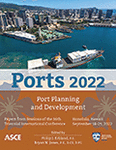Coupled Modeling Approach to Quantify Shoreline Erosion and Beach Morphology due to Passing Vessels
Publication: Ports 2022
ABSTRACT
Deep-draft vessel waves are found to play a significant role in shoreline erosion due to their larger height and longer period. Currently there are many numerical models that predict shoreline changes caused by natural processes such as tidal currents and waves. However, a modeling system that efficiently simulates both vessel-induced hydrodynamics and morphological changes is not typical. A modeling system was therefore developed by coupling two highly validated models used for predicting vessel hydrodynamics and morphological processes. The modeling system also utilizes historical ship tracking data to automatically process relevant vessel events over a given period to be used for predicting long-term shoreline impacts. The paper discusses the development and advantages of the modeling system using applications involving shoreline sections in bays where deep-draft vessels are frequent. The paper presents results of hydrodynamics as well as sediment erosion, transport, and deposition associated with vessel events.
Get full access to this article
View all available purchase options and get full access to this chapter.
REFERENCES
Agarwal, A., Fenical, S., Mcelhinney, K., and Carangelo, P. (2016). “Tanker-Induced Surges/Breaking Waves in Harbors.” 14th Triennial International Conference June 12–15, 2016 | New Orleans, LA.
Donna, M. B., Mitchell, M. M., and Davis, J. (2019). “Defining boat wake impacts on shoreline stability toward management and policy solutions.” Ocean & Coastal Management: Volume 182.
Fenical, S., Kolomiets, P., Kivva, S., and Zheleznyak, M. (2006). “Numerical Modeling of Passing Vessel Impacts on Berthed Vessels and Shoreline.” ICCE 2006.
Fenical, S., and Salcedo, F. (2016). “Simulating Complex Passing Ship Hydrodynamic Phenomena.” 14th Triennial International Conference June 12–15, 2016 | New Orleans, LA.
Hammack, E., and Tate, J. N. (2008). Considerations for Modeling Vessel Generated Currents and Bed Shear Stresses. United States Army Engineering Research and Development Center.
Houser, C. (2010). “Relative Importance of Vessel-Generated and Wind Waves to Salt Marsh Erosion in a Restricted Fetch Environment”. Journal of Coastal Research, 26(2), 230–240. http://www.jstor.org/stable/40605449.
Roelvink, J. A., and Banning, G. V. (1995). “Design and development of DELFT3D and application to coastal morphodynamics”. Oceanographic Literature Review, 11, 925.
Roelvink, D., Reniers, A., van Dongeren, A., van Thiel de Vries, J., McCall, R., and Lescinski, J. (2009). “Modelling storm impacts on beaches, dunes and barrier islands.” Coastal Engineering, 56, 1133–1152. https://doi.org/10.1016/j.coastaleng.2009.08.006.
US Department of Homeland Security. (2020). “AIS Frequently Asked Questions.” https://www.navcen.uscg.gov/?pageName=AISFAQ.
Zaggia, L., Lorenzetti, G., and Manfé, G. (2017). “Fast shoreline erosion induced by ship wakes in a coastal lagoon: Field evidence and remote sensing analysis.” PLoS One. 2017, 12(10).
Information & Authors
Information
Published In
History
Published online: Sep 15, 2022
Authors
Metrics & Citations
Metrics
Citations
Download citation
If you have the appropriate software installed, you can download article citation data to the citation manager of your choice. Simply select your manager software from the list below and click Download.
